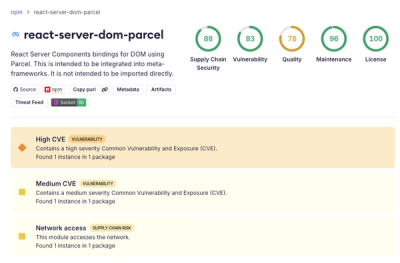
Security News
Deno 2.6 + Socket: Supply Chain Defense In Your CLI
Deno 2.6 introduces deno audit with a new --socket flag that plugs directly into Socket to bring supply chain security checks into the Deno CLI.
flunc
Advanced tools
Flunc: a functional test suite runner for web applications.
We recommend installing into a Virtualenv_.
You should be able to install flunc by using easy_install flunc; or
you can download the tarball, extract, and run python setup.py develop.
Flunc tests are Twill_ scripts.
There is a firefox extension that allows you to record tests directly from within your browser. To install, visit
These tests are saved in an xml format. You can convert these tests into a twill script by executing
testgentotwill recorded.html > twillscript.twill
Of course, you can still write tests manually.
Run flunc --help for details on running the functional tests.
By default flunc will search ./ftests/ to find tests. You can change
this with the -p (--path) option.
Some examples:
flunc all
runs all tests listed in all.tsuite against http://localhost/
flunc -t http://localhost:8080/some_portal all
runs all tests listed in all.tsuite against localhost:8080/some_portal
flunc -c all create_user
runs create_user.twill using all.conf
flunc -c all create_user login create_project destroy_project destroy_user
specify an ad hoc suite creating and tearing down a user and project on default host
Individual tests are contained in
.twill
A suite of tests are contained in
.tsuite
Suite configurations are contained in
.conf
Cleanup suites are run after a suite, and are in
_cleanup.tsuite
More details are on the Flunc homepage_.
.. _Virtualenv: http://pypi.python.org/pypi/virtualenv
.. _Twill: http://pypi.python.org/pypi/twill
.. _Flunc homepage: http://www.coactivate.org/projects/flunc
Better behavior for the error case where search path (-p option) is nonexistent or not a directory (egj)
Add optional second argument to url_qs command in flunc.urlinspector
which, if present, asserts the value of the given querystring parameter,
as well as asserting its presence. (egj)
Add new command css_len in flunc.xpath which lets you test that
a given CSS selector matches exactly N elements in the page (egj)
Add extension module flunc.urlinspector with a command url_qs for
making simple assertions about the current url's query string (egj)
Add notfind_in_css command to flunc.xpath (egj)
Display a more meaningful error message for invalid argument-passing syntaxes (egj)
Add a zope_cleanup.opencore_user_cleanup method to flush the opencore
member cleanup queue when deleting users. No hard failure if you have a
version of opencore that doesn't support this (pw)
Add find_in_css command to flunc.xpath module. Use it to find a regex
within a given CSS selector, like find_in_xpath (egj)
Transfer binary data directly to the twill script for passed-in param values instead of escaping it as a string (cabraham)
Add two twill extensions to checkbox.py: not_selected, is_enabled (pw)
Change is_selected to work correctly with checkboxes, I think (pw)
Change default host to http://localhost (pw)
Don't display BadRequest exceptions when calling zope_delobject() -- those are normal and just add a lot of noise (pw)
Added twill extension to support xpath. This introduces a dependency on lxml. There is one function added: find_in_xpath (rmarianski)
find_in_xpath runs a find command on the html result of an xpath expression For example: {{{ extend_with flunc.xpath find_in_xpath "People" "//div[@id='oc-pageNav']" }}}
Altered the namespace behavior; now there is no leading dot to specify the global namespace. (jhammel)
Instead, we use a scope-based model:
items (tests, suites, configuration) is first looked up relavent to the current (local) namespace
if they are not found locally, they are looked up in the global namespace
The dot is still used for namespace separation. So looking up foo.bar will first look for the namespace foo in the local namespace; if this exists, it will try to look up bar in that. If foo is not a namespace relavent to the current one, it will try to look up foo.bar in the global namespace.
Added hierarchal namespaces to tests (jhammel)
Formerly, tests lived in a flat namespace. Using --recursive, one could put all tests under the root directory into a single namespace. Now each directory has a namespace associated with it. Tests or suites with single names refer to items in the same namespace (that is, the same directory). You may refer to the bar test or suite in the foo subdirectory as
foo.bar
If a suite has the same name as the subdirectory name, you may refer to it either with the full specification
foo.foo
or with shorthand
foo
To refer to the global namespace, preface the name of the test, suite, or path with a dot
.foo.bar
refers to the bar suite or test under the foo directory under the root directory.
These changes should be backwards compatible with existing tests and were made to facilitate test organization with the hope of providing the flexibility to manipulate namespaces when tests live in multiple locations on disc.
FAQs
Functional test suite runner
We found that flunc demonstrated a healthy version release cadence and project activity because the last version was released less than a year ago. It has 3 open source maintainers collaborating on the project.
Did you know?

Socket for GitHub automatically highlights issues in each pull request and monitors the health of all your open source dependencies. Discover the contents of your packages and block harmful activity before you install or update your dependencies.

Security News
Deno 2.6 introduces deno audit with a new --socket flag that plugs directly into Socket to bring supply chain security checks into the Deno CLI.

Security News
New DoS and source code exposure bugs in React Server Components and Next.js: what’s affected and how to update safely.

Security News
Socket CEO Feross Aboukhadijeh joins Software Engineering Daily to discuss modern software supply chain attacks and rising AI-driven security risks.